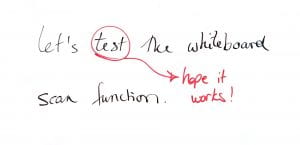Letters from the front
As someone who has used point rubrics extensively, I have a pretty good sense of how to calculate number grades, but a recent conversation with colleagues has made me question if number grades are really my preference, or just my Cégep conditioning.

I have spent more than fifteen years teaching at the Cégep level, where course grades are reported in percentage, and 60% is the minimum passing grade. I am now teaching in the university system, and we report course grades as letters, with a D- as the minimum.
Number grades make a lot of sense for evaluations that are straightforwardly quantifiable, but what’s the difference between an essay that gets 87% and an essay that gets 85%? Where does one student lose or gain 2%? In this sense, grading with a range seems more feasible—both of these essays get an A, and there’s no uncomfortable quibbling over one or two percentage points [I’m well aware that some students will quibble no matter what grading system one uses, but you get my point].
Is Room for Improvement Justification for Downgrading?
The facet of the conversation that truly gave me pause, though, was one colleague saying matter-of-factly that you just can’t give a perfect grade. If an essay is graded on 10, no student is going to get 10/10. When I asked the colleague to explain, the response was that “there’s always room to improve” in writing. It’s fair to say that this was not the first time I’ve encountered this position, and my colleague is far from alone in taking this approach to grading.
But while I agree that writing can usually be improved with a little more time or scrutiny, my objection to this stance is that the grade should reflect the task and learning objectives. If I were teaching math, and created a ten-question test, each question worth one point, then it’s pretty easy to see that a student could very well achieve a perfect score. Assuming that the test is valid, the 10/10 result demonstrates that this student has learned what was being tested. In my mind, this same thinking can be applied to more “subjective” disciplines, such as writing. If my test is designed to assess student learning on a specific concept, and a student has demonstrated absolutely that they’ve met the objective, then why is a perfect score not possible? I argue that deciding in advance that a perfect score is impossible means that you are assessing elements of the writing that are not actually part of the stated objectives.
For example, if I have assigned a first-year class a five-paragraph comparative essay, and have provided a detailed rubric—or at least a detailed overview of what I am evaluating, my standard for grading is “what does an excellent first-year, five-paragraph, comparative essay look like?”, not “what does a fourth-year, ten-page research paper look like?” How can I evaluate students on concepts and skills that they have not yet encountered?
I think it is entirely justifiable, and in fact, pedagogically ethical, to grade according to level. An excellent first-year paper may well be only an adequate third-year paper—so if the paper is submitted in a third-year course, it gets an adequate grade, but if it’s submitted in a first-year course, it gets an excellent grade. Otherwise, we are punishing students for being first-year students, not evaluating their work according to the standards of the level. When I shared this thought with a friend who teaches physical therapists, she agreed, and pointed out that her students complete four practical stages. The fourth stage is just prior to certification, and naturally, students at that stage are expected to be, essentially, professionals with all the knowledge and skill that implies. Students doing the first stage, on the other hand, have not learned the same content yet, nor have they been exposed to the same skillsets. So students in the first stage are evaluated on the objectives specific to that stage—otherwise, if they were evaluated according to the expectations of the final stage, they would not be able to advance.
A for Effort
So I have decided to give letter grades a try. I have created a rubric for interpreting the grades, shared below.
My number-based rubrics will still come in handy. First, they are an excellent source for articulating criteria and expectations for specific assignments. They’ll also allow me to keep a separate record of student performance to use when calculating final grades, in case there are any hard-to-assess cases.
The number-based rubrics I have been using for the past decade and a half were not birthed fully formed. I tweaked and revised and edited and adjusted over and over. While I feel that these rubrics are excellent reflections of my assessment practice, there’s always room for improvement 😉
Please feel free to provide feedback on the letter rubric, ask questions, and share your own approach!
Interpreting letter grades for major assignments
Note that a minus (–) grade typically indicates that your work is mostly situated in the letter range but has some areas of weakness or elements missing. A plus (+) grade indicates that your work is mostly situated in the letter range but demonstrates better performance in some areas.
| Grade | Overall | Your work demonstrates: |
| A | Excellent, exceptional work | Your work not only meets all the criteria for this assignment, but demonstrates originality, creativity, professionalism and exceptional engagement in the project. You have clearly gone above and beyond the basic requirements, and your organization, critical thinking, and understanding of the key concepts are outstanding. Meets well, or even exceeds, expectations for this level and topic. |
| B | Strong, competent work | Your work clearly and strongly meets all the criteria for this assignment. You have clearly engaged yourself in this project, and have demonstrated good organization, critical thinking, and a strong grasp of the key concepts. Meets expectations for this level and topic—there’s room for improvement, but continuing to work at this level will lead to success in the course. |
| C | Acceptable work | Your work basically meets most or all of the criteria for this assignment. You have engaged yourself in the project, but your organization, thinking, and understanding of the key concepts is limited. Satisfies the minimum expectations for this level and topic—you should be aiming for better performance in subsequent assignments. |
| D | Acceptable but unsatisfactory work | Your work struggles to meet the criteria for this assignment. It is not clear that you have engaged yourself in the project, and your work lacks organization and critical thinking. You seem to be unclear on some of the key concepts. Fails to meet the minimum requirements for this level and topic—you need to perform better in subsequent assignments to succeed in this course. |
| F | Unacceptable work |
Your work fails to meet the minimum criteria for this assignment. You do not appear to have engaged yourself in the project, and your work is disorganized and lacks understanding of the basic concepts. Unacceptable for this level and topic—you need to perform significantly better in subsequent assignments if you intend to continue in this course. Note that this grade will also be assigned to any work not submitted. |
| NG | Not Graded |
Your work does not seem to address the purpose of the project. You may have misinterpreted the assignment instructions. Your resubmission may be accepted after consultation with the professor. Note that this grade may also be assigned as a placeholder for deadline extensions. |
